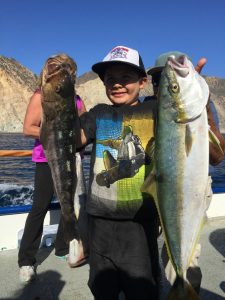
The waters off Newport’s coast continue to lure eager anglers for a chance to reel in a memory—and dinner.
By Briana Verdugo
It’s a feeling like no other: The gentle tug on the line, a subtle fidgeting at the end of your fishing pole as you wait with absolute focus to see if there’s a bite and, subsequently, a fight to land your reward. Your hand is positioned on the reel, ready to set it into motion as soon as the rod arches, signaling you chose well when selecting your bait and casting location. It’s a moment with second guessing and hushed anticipation—was that a nibble? Did it take the bait? Should I start to reel? Then, the fish swims away with your hook and line spools off, signifying it’s time to do your job and bring it in. Muscles engaged with each crank of the reel, you are grateful for the fish’s fight, a worthy competitor until the moment you bring it over the rail of the boat.
Fishing is an ancient activity that has captivated men and women since the Paleolithic period: Evidence found in an East Timor cave shows humans have been plying the deep sea for food for some 40,000 years. While many around the world still fish with the simple goal of bringing home something to feed their family, others choose to partake in the sport for the thrill of the catch, with the added perk of fresh fish to take home.
Newport Beach offers a departure point for some of the best fishing in all of Southern California. Local operators Davey’s Locker and Newport Landing craft experiences for guests that harken back to to the area’s history as a hub for sportfishing. As the waters along the coast heat up, drawing in a wealth of fish like yellowfin tuna and, periodically, mahi-mahi, the boats gear up to help eager anglers bring in a bounty. From gear choices to the best places to drop anchor, Newport’s fishing captains and crews help new and experienced anglers reel in a meal.
Newport’s Draw
Walking along the docks of Newport Harbor to start a fishing trip is more than just a fun summer excursion, it’s a tie to the Newport of yore, when Balboa Pavilion was a highlight of the area and the center of sportfishing activity in Southern California. Following World War II, there were more than 100 local sportfishing boats in operation, based out of nine landings. Today, that number has dwindled down to two landings and a handful of boats, but the area continues to be a hub for sportfishermen.

There are several reasons for Newport’s prominent position as an angling locale, according to Donald Brockman, president of Davey’s Locker, which runs more than 400 fishing trips per year out of this city. “We’re very close to the entrance of the harbor, so it doesn’t take a long time to get out,” Brockman says, meaning there is less time idling at a slow speed before reaching the open ocean and actually dropping a line. He also believes that, as a launch point, Newport is in a great position on the coast. “I think we’re really centrally located for fishing,” Brockman says. He notes that whether the fish are biting closer to San Pedro up north or near San Clemente Island in the south, boats coming from Newport Harbor have the ability to get to the prime spot with less travel time. Best of all, Santa Catalina Island sits a little more than 30 miles off the coast and is a hot spot for fishing activity.
Finding the Fish
Often, where a boat will drop its anchor depends greatly on how long the trip is—the longer the jaunt, the farther out a boat will venture. Davey’s Locker and Newport Landing operate three different types of excursions: half day, full day (also called three-quarter-day) and overnight outings, as well as an evening “twilight” trip during the summer months.
On half-day trips, which lasts between five and six hours, captains might choose to pull up alongside a vast kelp bed not far off the coast where fish often live and travel through. “The half day boat, he just fishes within an hour north or south of here, through the kelp [beds],” Brockman says. “They’re very limited on time so they’re limited on what they can do.” For beginners, a half day trip might be a great option, but there’s also no harm in jumping into the deep end, in Brockman’s opinion. “A half-day trip is a good way to introduce yourself [to fishing], but a three-quarter-day trip gives you an adventure for a whole day,” he says.

The Freelance, a fishing boat owned by Brockman, offers such an excursion that departs the pier at 7 a.m. and returns at about 5 p.m. That added time means the vessel can venture farther off the coast to places where different types of fish may be waiting. “Normally, 75 percent of the time, we fish [off] Catalina Island,” Brockman says. Beyond fishing, guests on their way out to the island might experience other exciting events, “On a three-quarter-day trip, if you go to Catalina, you’ve got a good chance of seeing whales and dolphins,” Brockman says. “There’s a lot of dolphins between here and Catalina.”
For those who have tried a couple of trips and are ready for the next level of fishing, an overnight experience is a great way to make sure you come home with plenty of bounty from the sea. Anglers load the boat one night and come back from their adventure the next evening. When the season is right (generally between July and November), these trips are the best for chasing tuna as the captain has more flexibility with where to go and can head 40 to 70 miles from the coast. If the tuna aren’t around, there’s still hope. “You might go chase tuna half the day and nothing’s biting, then you’ll fall back … [to] Catalina and catch some bass or perch or rockfish,” Brockman says.
In the Bag
For some, it’s the adventure of fishing that makes the experience worth it, even if they have to buy their seafood at the local supermarket on the way home from the harbor. As Brockman says, “That’s why they call it fishing, not catching.” But for those who put a high stake on what they get to take home, it’s worth noting the wide variety of fish that can be caught just off the coast.
It’s easy to get an idea of what’s biting even before heading down to the harbor by checking out the daily fish counts, which are updated regularly on the Newport Landing and Davey’s Locker websites. Catches change depending on the season, but, in general, species found off the local coast include sand bass, rockfish, halibut, yellowtail, calico bass, bonito and barracuda. During the right times of year, when warm waters roll in, yellowfin tuna can be caught father out to sea.

In general, boats will carry anchovies, sardines or squid as bait for the different fish. More advanced anglers might bring along a tackle box with an assortment of jigs and lures that are crafted with different colors, designs and shapes to catch a specific fish’s eye with a bit more precision. Brockman notes that new fishman need not bring any equipment, as rods, reels and all other necessities can be rented at the dock, but after a few times out on a boat, it’s easy to become enamored with the many different types of tools available to fishermen and most sporting goods stores will have basic gear in stock for those seeking to invest in their own.
Whether you’re an experienced angler or fledgling caster, the ship’s crew is there to aid you in any way possible. “They’re there to help and all you have to do is ask,” Brockman says of the deckhands who work on every boat. From tying a certain knot to baiting a hook or even helping to untangle a knot between two anglers’ lines, the ship’s crew is well versed in the details of successful fishing. “There are a lot of tricks to [fishing] and … they’re the experts. They want you to catch fish,” Brockman explains.
No matter if you head home with a bag full of fresh fish or just a wealth of great memories, a day out at sea can refresh the senses and revitalize the spirit. Long rides out to the deep reaches of the ocean offer an opportunity to relax and gain perspective, then, in an instant, a fish may bite and pull you into a flurry of excitement and activity. It’s a hobby that’s sure to have you hooked and coming back for more.
Taste of Success
(A Recipe)
After a day on the water, returning home with a bag full of fresh fish is the ultimate success, but once back on dry land, deciding how to cook your catch is the next challenge. To help with that, we reached out to the chefs at The Ritz Prime Seafood for an easy recipe to take your fish from the sea to the plate. Click on this link for the recipe.




